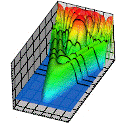Department of Physics and Astronomy: Publications and Other Research
Date of this Version
11-15-2013
Citation
PHYSICAL REVIEW A 88, 053412 (2013); DOI: 10.1103/PhysRevA.88.053412
Abstract
The high-order harmonic-generation (HHG) spectrum of Be is investigated in the multiphoton regime by solving the full-dimensional, two-active-electron, time-dependent Schr¨odinger equation in an intense (≈1013 W/cm2), 30-cycle laser field. As the laser frequency ωL varies from 1.7 to 1.8 eV (which is in the tunable range of a Ti:sapphire laser), the seventh harmonic becomes resonant sequentially with the transition between the ground state and two doubly excited autoionizing states, 2p4s(1P) (at ωL = 1.734 eV) and 2p5s(1P) (at ωL = 1.785 eV), while the third harmonic becomes resonant with the 2s2p(1P) singly excited state (at ωL = 1.766 eV). At each of these resonant frequencies, the HHG power spectrum is found to increase by an order of magnitude over a range of harmonics that form a plateau, extending from the resonant harmonic up to a cutoff at the 25th harmonic. In contrast to the well-known rescattering plateau cutoff law appropriate in the tunneling regime (which predicts a cutoff at the fifth or seventh harmonic), the multiphoton regime plateau we find for Be originates from atomic resonance effects. Off resonance, the Be HHG spectrum decreases monotonically with harmonic order. By taking the ratio of the integrated harmonic power of the seventh harmonic to that of the fifth harmonic, one can isolate the resonant effects of the two doubly excited states in the HHG spectrum from those of singly excited resonance states. These ratios exhibit resonance profiles for driving laser-pulse durations much longer than the lifetimes of these autoionizing states. The energy widths of these resonance features are comparable to the widths of the laser pulse and are much smaller than the autoionizing state widths. These results demonstrate an important role for electron correlations in enhancing harmonic-generation rates in the multiphoton regime.
Included in
Atomic, Molecular and Optical Physics Commons, Elementary Particles and Fields and String Theory Commons, Plasma and Beam Physics Commons


Comments
Copyright © 2013 American Physical Society. Used by permission.